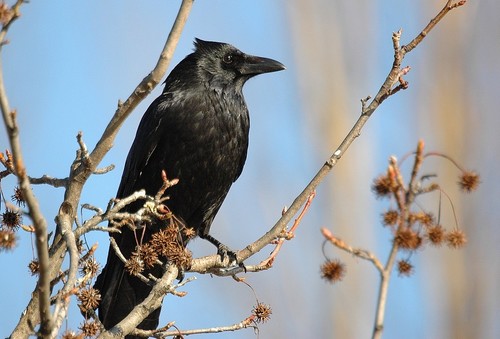
Carrion Crow
The Carrion Crow (*Corvus corone*) is a widespread and highly adaptable bird species belonging to the Corvidae family, known for its intelligence and opportunistic behavior. It plays a significant ecological role as both a scavenger and a predator, contributing to the breakdown of organic matter and controlling populations of small animals. While often viewed negatively due to its association with carrion, it is a crucial component of many ecosystems. The Carrion Crow is not globally threatened, but localized declines have been observed in some areas due to habitat loss and persecution.
44-51 cm
Length
84-100 cm
Wingspan
Least Concern
Conservation Status
Distribution
The Carrion Crow is found across Europe and East Asia. Populations are largely resident, although some northernmost birds may migrate south in winter. It is absent from Ireland, where it's replaced by the closely related Hooded Crow. They have altitudinal range from sea level up to mountainous regions.
Lifespan
Typically 4-8 years in the wild, but can live up to 15 years or more.
Carrion Crow's Habitat
Habitat Types
Woodland, Farmland, Moorland, Coastal cliffs, Urban areas, Parks
Climate Zones
Temperate, Boreal
Adaptations
Carrion Crows are highly adaptable, thriving in a variety of habitats due to their generalist diet and intelligence. They can tolerate human presence and exploit human-altered landscapes effectively.
Variations
Two main subspecies are often recognized: *Corvus corone corone* (Western Carrion Crow) and *Corvus corone orientalis* (Eastern Carrion Crow). These differ slightly in size and plumage, with the Eastern form having a slightly larger bill.
Appearance
Breeding Plumage
Plumage is similar year-round.
Seasonal Feather Changes
No significant seasonal variations; plumage may become slightly worn before the annual moult.
Sex Based Plumage Differences
Minimal; males and females have very similar plumage.
Notable Features
All-black plumage with a glossy sheen., Strong, black bill., Black legs and feet.
Diet and Feeding
Primary Foods
Invertebrates, Carrion, Seeds, Fruits, Eggs and nestlings of other birds, Small mammals, Human food waste
Foraging Behavior
Carrion Crows are opportunistic omnivores, foraging on the ground, in trees, or occasionally in shallow water. They use a variety of techniques, including probing, pecking, and tearing. They are known to cache food for later retrieval.
Specializations
Their strong bill allows them to access a wide range of food sources, from cracking nuts to tearing flesh.
Seasonal Diet Variations
Diet varies seasonally depending on food availability. In spring and summer, invertebrates and the eggs and young of other birds are important. In autumn and winter, seeds, fruits, and carrion become more prominent.
Behavior
Social Structure
Carrion Crows are generally solitary or found in pairs, but may form small flocks outside the breeding season, particularly at abundant food sources or roosting sites.
Communication
Harsh 'caw' calls., Rattling calls., Clicking sounds., Visual displays, such as bowing and wing-flicking.
Migration
Most populations are resident, but some northern populations may undertake short-distance migrations in response to harsh winter conditions.
Territorial or Group Behaviors
During the breeding season, pairs defend territories around their nest site. Outside the breeding season, they may form loose flocks and communal roosts.
Conservation
Threats
Habitat loss and degradation, Persecution by humans (shooting, poisoning), Pesticide exposure, Collisions with vehicles and power lines
Protection Programs
General wildlife protection laws in many countries.
Local National Laws
Protected under various national wildlife laws, though some exceptions may exist for control of perceived pest species.
Population Trend
Stable
Population Estimates
The global population is estimated to be very large, with millions of individuals.
Interesting Facts
Carrion Crows are highly intelligent.
They are known for their problem-solving abilities, tool use (in some populations), and ability to recognize individual human faces.
They can remember the faces of individual humans.
Studies have shown that they can distinguish between threatening and non-threatening individuals.
They sometimes cooperate with other crows to mob predators.
This behavior helps to drive away potential threats to themselves or their young.
Faqs about Carrion Crow
Are Carrion Crows dangerous to humans?
No, Carrion Crows are not typically dangerous to humans. They may become aggressive if they feel threatened or if their nest is disturbed, but attacks are rare.
What is the difference between a Carrion Crow and a Raven?
Ravens are much larger than Carrion Crows, with a heavier bill, a shaggy throat, and a wedge-shaped tail. Carrion Crows have a more rounded tail and a smoother throat.
Do carrion crows mate for life?
Carrion crows are generally monogamous and form long-term pair bonds, often lasting for several years or for life. However, 'divorce' can occur, particularly after breeding failures.
Copyright @ Nature Style Limited. All Rights Reserved.
 English
English